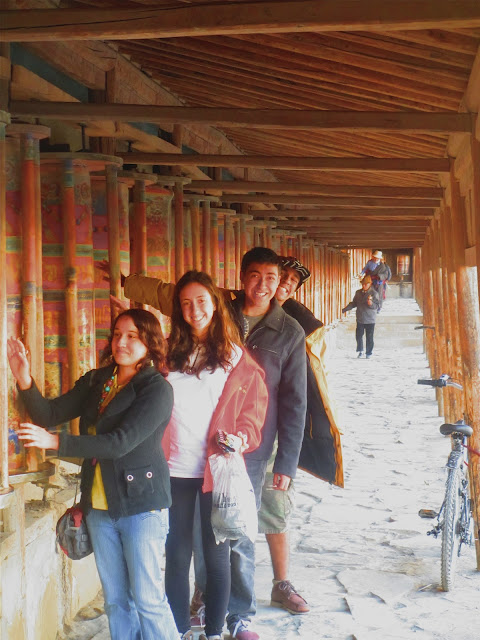Leaving Xinjiang Province, in Northwestern China, Sam and I parted ways. He took the train into the Kazakhstan (and then onto Kyrgyzstan and Uzbekistan, which, after studying his Lonely Planet Central Asia guide assiduously, now know where they are in relation to each other and how they are generally different) and I flew a few hours east to the town of Lanzhou in Gansu Province. The students were taking the train from Beijing and we met there. Gansu and Lanzhou were a major part of the ancient "Silk Road", but most interesting for me/us is that it is where Han China starts to blend into minority Chinese groups and in particular here, Tibetans. The school trip had a two fold mission, first to immerse ourselves in Tibetan culture and the second, to meet up with a local school to do a visit (more on that to come in a later post). My two weeks in Western China have really given me a sense that the homogeneity of China is complete wrong. This is a country with political borders that encompasses people's of all different races, religions and beliefs. Our stop on the Tibetan plateau (not political Tibet, but an area that is predominantly Tibetan in culture and feel) was the town of Xiahe, home of the famed Labrang Monastery (founded in 1709), one of the six more important monasteries of the yellow hat sect, and the largest outside of political Tibet.
 |
| I start with this picture because I love this part of our SYA-China trips. It's roll call, but it's done with our students Chinese names. |
 |
| So, the description of "monastery" was a bit misleading, at least for me. The Labrang Monastery is more of a "college." Monks (and there were some women too) come here to study, pass some general practice and then get admitted to different institutes (medicine, debate, meditation etc) within the monastery to study for the rest of their lives. |
 |
| There are about 2,500 monks here at Labrang. They live in town. They aren't "Amish" like I thought. They have cell phones and use taxis and generally live like the rest of us in the "day to day" lives. |
 |
| One important part of the monastery is the "kora" or spinning of the prayer wheels (which I think symbolize keeping prayers in motion/going all the time). It's a 3km path around the monastery and there are about 1,000 wheels. |
 |
| Along the "kora" there are devoted Buddhists that prostrate themselves as a sign of devotion. It's take a step, down on your knees, lay down, pray, get up and do it all over again. Apparently, there are some Buddhists who start from their homes and do this for thousands of kilometers on their way to Buddhist holy sites. |
 |
| I wonder if a black cat under a Buddhist prayer wheel is a bad sign? Do they cancel each other out? Am I mixing religion and superstition? I'm confused! |
 |
| Many of the monastery buildings were destroyed in the Cultural Revolution and are just recently being rebuilt, such as this one in 2007. |
 |
| There are a number of taller buildings that are more square in plan in which house HUGE Buddhas, each with a different name. I respected the wish for no pictures! |
 |
| The Labrang Monastery abuts a large hill and those small houses in the hills are supposedly refuges for monks who want to spend some time in isolation. |
 |
| All of a sudden, as we were walking around, horns (not electronic) starting sounding. Looking up, we saw these men blowing into a horn, which must have been a call to prayer. |
 |
| Because all of a sudden there was a buzz of activity. |
 |
| Monks walking everywhere. |
 |
| And then a pile of shoes as they entered into the main prayer hall. Again, no pictures, but I got to peek in. It's dark inside and they sit in rows perpendicular to pews in a traditional church and face each other. There is burning of paper and other rituals, but I didn't really know what was going on. |
 |
| Ex-students of mine will know my "issue" with Uggs. I wonder if this is where they originated? |
 |
| An UNEXPECTED treat. As we were wandering around Labrang Monastery, we walked into a courtyard and witnessed a prayer ceremony. WOW! |
 |
| I LOVE this photo. Boy monk on his PSP. The collision of two worlds. |




















































